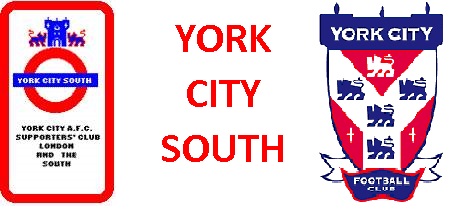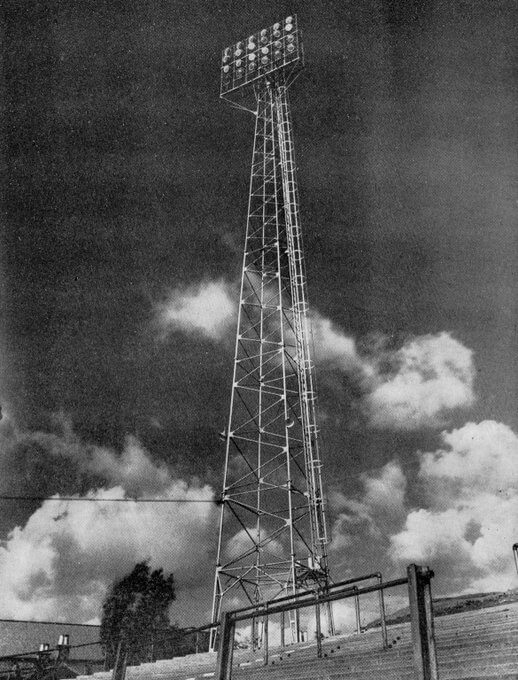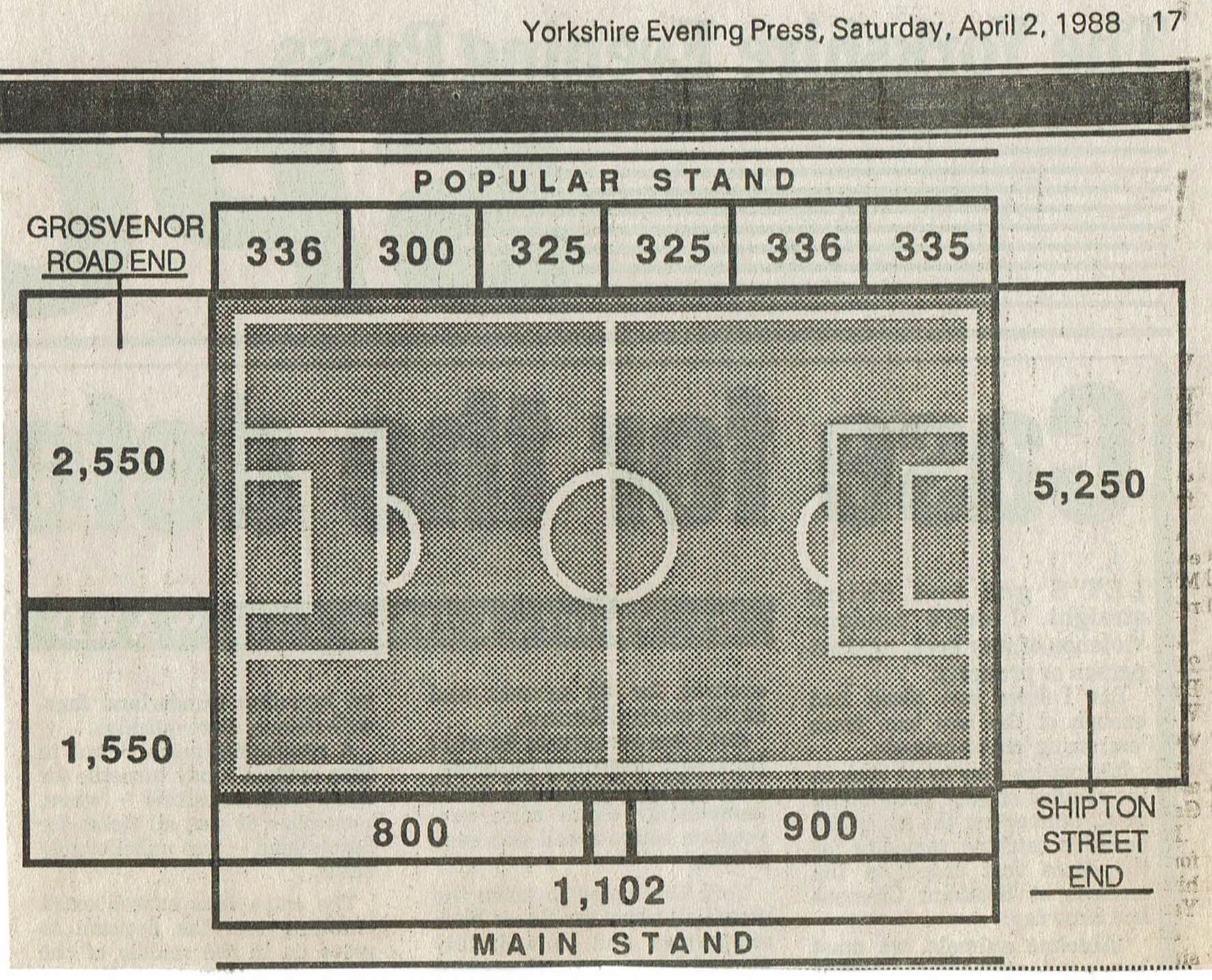

Bootham Crescent - Spot The Differences
Much hard and unpaid work from the supporters went into building The Popular Stand during the 1930s. They piled earth up to make the incline and then erected the structure.
The 1950s saw further significant improvements as a result of the 1955 FA Cup run which saw City lose narrowly to Newcastle in a semi final replay. The main improvement was an extension to The Main Stand. Spot the difference, if you looked closely, you will still see the join, the brick work in the section which houses The Family Stand is built using a slightly different colour brick. Later developments have made the join even harder to spot. As last as the very early 1970s, the 2 outer sections of The Main Stand were bench type seating whilst the middle 2 sections were seats with backs. The benches were wooden blanks mounted on concrete with a line of paint denoting each seat.
Another improvement of the 1950s was the erection of our first floodlights at a time when many other clubs were coming out of the dark ages. No more 2 o’clock kicks on a winter Saturday, midweek kicks also used to be 2 o’clock and meant many an afternoon off school or work for many supporters.

I seem to recall the original floodlights got christened on 3 different occasions, including a friendly with Newcastle for the official opening, the first switch on during a game and the first game they were on from the start.
The late 50s and 60s saw only a few further minor improvements.
When I started supporting City in the late 1960s, the club was run down, no club shop (a wooden hut sufficed) and cramped office accommodation. The car park was a mud heap and doubled as a training pitch. In those days a player with a car was a rarity, to pay their way, many worked as painters during the summer, Tom Lockie employed the players in the summer to re-paint Bootham Crescent. Many were the times I waited in the car park for autographs and many were the times I got my feet soaking wet when trying to walk around (or probably through in those days) the puddles. Tarmac arrived in the early 1970s.
The big step forward was promotion to (the original) Division 2 in 1974, just one division away from the top division. Thoughts of games against the giants of the game became a reality as we played Manchester United, Liverpool, Arsenal, Chelsea and Aston Villa.
To celebrate promotion, The Popular Stand was seated, the seats being bought second hand from Manchester City. Talk of a double decker Popular Stand never became a reality.
Big games at the height of the 70s hooliganism era had their drawbacks. It was around this time that City moved the home end from The Grosvenor Road end to the current Shipton Street end. City didn’t want 7,000 Manchester United hooligans working through the car park. One of those "hooligans", John Byrne later went onto star for City.
In the very early 1970s, we also lost the use of our tunnel. A tunnel runs the length of the ground behind The Popular Stand and allowed free access from end to end. Both sets of supporters could watch the entire game stood behind the goal their team was attacking, passing each other in the tunnel at half time. It worked for many years without any kind of violence.
1974's promotion to Division 2 gave rise to grandiose ideas for ground expansion. Thoughts included buying The Territorial Army grounds behind The Popular Stand and the Shipton Street school grounds. Thoughts included turning the pitch through 90 degrees and double decker stands. A railway halt beside the footbridge over the railway by the City Hospital was also muted an as an option for keeping visiting hooligans out of the city centre. None of the plans ever came to fruition.
Another benefit of being in Division 2 was regular appearances on the Yorkshire TV Sunday afternoon soccer programme. We were the main match in November 1974 when we beat Norwich City 1-0, unfortunately, the poor quality of our lights allowed only first half highlights to be shown, and those were black and white, rather than colour. As a result, BBC pulled out of showing our game against Manchester United on Match Of The Day the following month. However, we had new lights for the next season, using the same pylons, each pylon had 30 rather 24 bulbs, each with much more brightness. These lights were to last for nearly 20 years when the current shorter pylons with even brighter lights were installed.
The 1975 lights were the only bright spot as City suffered 2 successive relegation seasons and plunged to bottom spot in The Football League. Money was tight, however, the gymnasium was built to give the players an indoor training area. Other ground improvements were minimal.
The 1984 Division 4 championship and the cup runs the following season marked the next round of ground improvements. Transfer and cup gate receipts meant the club had money in the bank. Most fans were disappointed as money was spent on more office accommodation, hospitality lounges, more sponsors' lounges, more turnstiles (but much smaller) and improved ground toilets. Many thought it should have been spent on team improvements. Uniquely, the sponsors' lounges overlooked the car park.
The late 1980s and 1990s have seen further improvements. The Main Stand was extended in stages as the family areas introduced. The standing enclosure in front of The Main Stand disappeared as that stand was extended forward and down to ground level. The David Longhurst Stand was built in memory of the former City star.

Vague thoughts during the Craig era to buy The Territorial Army grounds behind The Popular Stand never materialised. The mid 90s saw short lived plans for a double decker Grosvenor Road stand, local residents, lead by the Council leader were soon up in arms. The original terracing was suffering badly from structural defects. Subsequently, capacity at the Grosvenor Road end was reduced in stages as the defects worsened. Watch: Grosvenor Road end - 2011
At the other end of the ground, thoughts of an all seater ground remain just thoughts, whilst we enjoy life outside The Championship.
With Craig's exit, further expenditure on the ground became largely on a needs must basis.
Many things have changed over the years. One thing that will never change is our record attendance at Bootham Crescent. 28,123 packed into the ground in March 1938 to witness City play Huddersfield in The FA Cup. With various improvements (such as extra seating) and increased safety our final capacity was under 8,000.
Postscript: The Craig / Batchelor shenanigans meant we nearly lost our ground (and our club). Our board has worked tirelessly to rectify the situation and to move our club to a purpose built new ground. It finally come to fruition in 2021. It can be viewed that any money spent on improving Bootham Crescent since 2001 is wasted and only essential maintenance was undertaken. Some club reports estimate annual ground maintenance costs are £50,000 per year. In 2005, Bootham Crescent became Kit Kat Crescent following a major sponsorship deal. The deal expired in January 2010 when the ground reverted to its former name. Maybe another sponsor will take over ground naming rights.